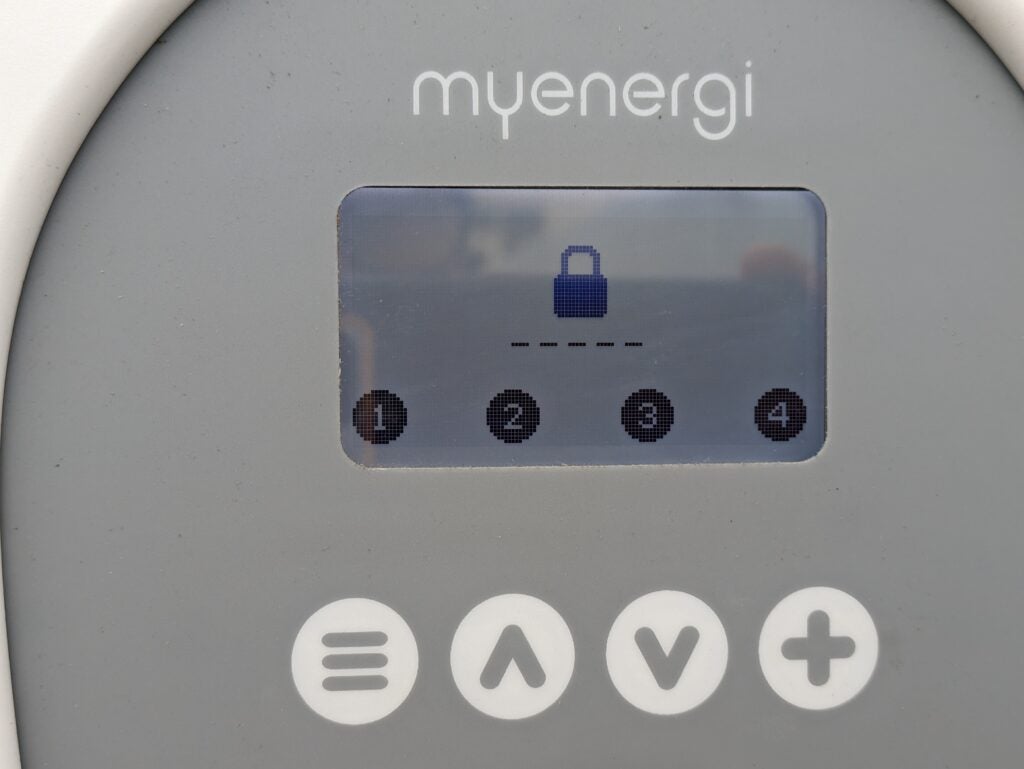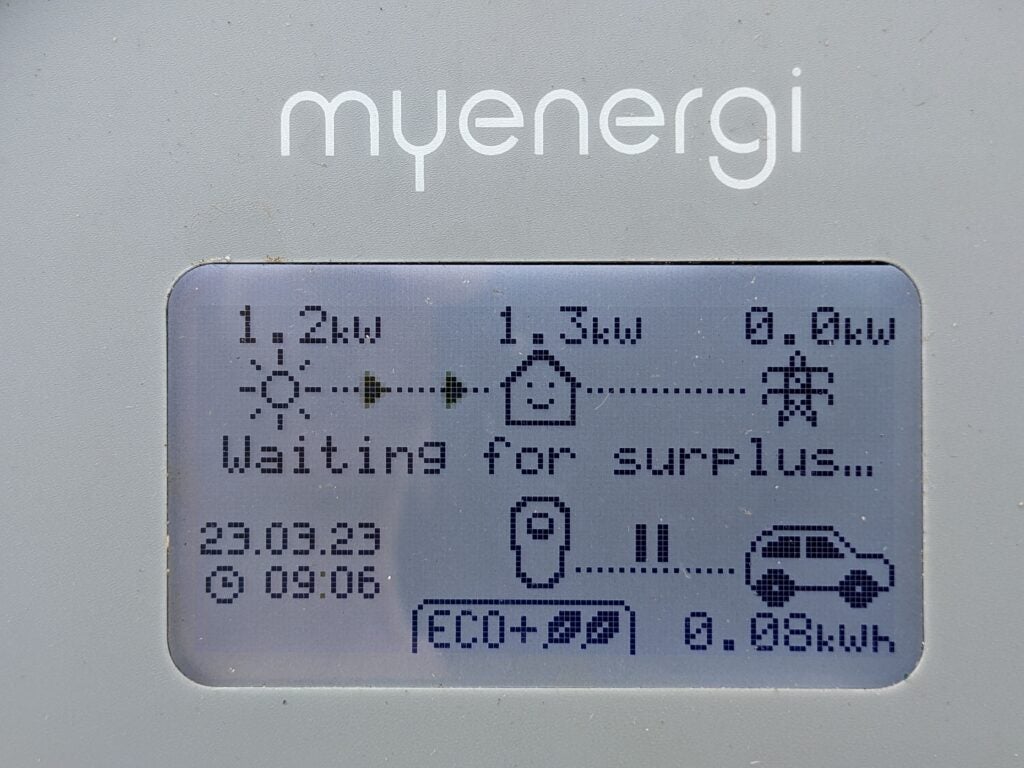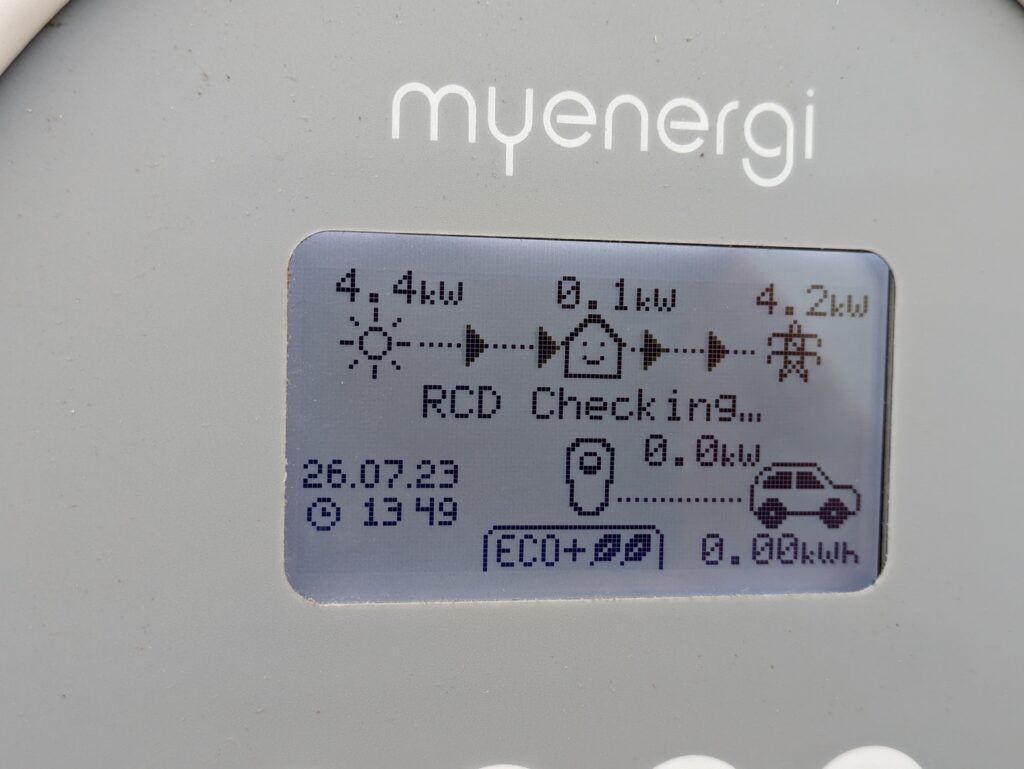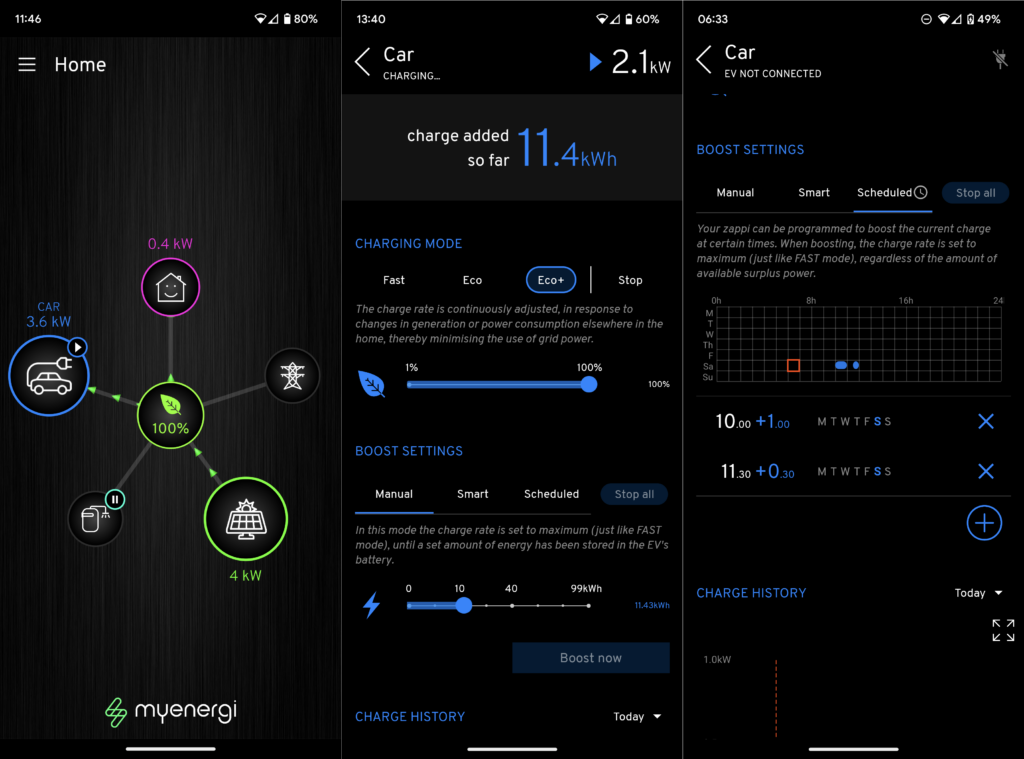MyEnergi Zappi Review
A solar-aware EV charging point that also works with cheap and variable tariffs






Verdict
MyEnergi’s Zappi might not be the smallest or best looking EV charger, but it offers a wide range of ways to fill up your electric car for the minimum possible price. It’s at its best when used in buildings with their own solar or wind generation, but its comprehensive scheduling and support for flexible tariffs means it can save anyone money. Even if that’s not your primary focus, this is still an adaptable EV charger that caters for a wide range of users.
Pros
- Supports home generation and load balancing
- Variable charge rates from 1.4kW to 22kW (three-phase)
- Powerful and reasonably easy app
Cons
- Doesn’t support vehicle to grid
Key Features
- Schedule or automate chargesCharge your EV immediately either from spare solar power, or with electricity from a grid. You can also schedule charges to make the most of cheap off-peak electricity rates
- App controlThe MyEnergi app helps you view and configure charging. It also works with other MyEnergi products
- Choice of modelsThere are white and black versions of the Zappi, with or without a cable, and supporting either single-phase or three-phase wiring
Introduction
MyEnergi’s Zappi charging point is a smart EV charger for homes and businesses. It’s available in four versions, each of which comes in white or black. Tethered Zappis have a type-two charging cable attached, while untethered models have a socket – you’ll need to use the type-two cable that came with your car.
You can choose from a single-phase model, suitable for most homes, or a three-phase version more suited to business premises with a 400-volt connection. The former supports a maximum seven kilowatts (7kW), while the latter can hit 22kW with vehicles that support it. Here we’re testing the white, tethered, single-phase model.
All Zappis can be used as stand-alone chargers in buildings without any renewable generation, and they have a decent set of features for this. However, they’re also designed to be aware of any generation, such as from solar panels or a wind turbine. This makes them a good choice for balancing load and generation, helping you get the best return from your green power source. The Zappi comes with a three-year warranty, which you can upgrade to five years.
Design and installation
- Reasonably smart design
- Very flexible installation options
- Doesn’t require earth point or RCD
The Zappi isn’t the smallest EV charger out there, but it’s got a sensible and reasonably tidy design. When it’s not in use you can wrap the tethered version’s thick cable completely around it, and stow its type-two connector in a neat socket on the front panel. With five metres of cable, the Zappi will just about reach the far end of most EVs, which is handy if you’ve parked the wrong way around. All the same, it’s best to take some measurements to make sure you’re putting it in the most sensible place.

The Zappi has a backlit mono display that’s navigated with four clicky buttons. Once set up, you’ll probably only use these to change the charge programme, or enter a lock code if you need to set one up to prevent someone ‘stealing’ a free charge.

The display itself shows whether the Zappi is charging, how much power it’s supplying, how much it’s supplied in total and – in more complex installations – information on how much energy your household’s generating or using.

While I’m normally happy to install basic electrical equipment, EV chargers are strictly a job for the professionals. A single-phase charger can draw a current up to 32A and supply 7kW – equivalent to about three kettles being boiled at once. You need a qualified electrician to put it on a dedicated circuit, and ensure that the resulting installation meets all the necessary safety standards.
Unlike many EV chargers, the Zappi doesn’t require a separate residual current device (RCD) or earthing point, which could reduce the cost or complexity of having it installed. It does require an internet connection, though, which can be either wired or wireless.

The single-phase Zappi comes with a CT (current transformer) clamp, which in a straightforward installation could be used as a grid sensor to monitor how much power the whole house is drawing from the grid. In many cases the Zappi will be near enough to your meter cabinet or fuse box that using this will be straightforward, but you can buy the optional Harvi wireless sensor if the cable is impractical.

If you have solar panels, a battery, or other generation equipment, it’s possible to fit additional sensors to make the Zappi aware of them – it can handle up to three CT clamps. For example, connecting a second clamp to the output from your solar panels gives the Zappi oversight of the green electricity you’re generating. Fitting a clamp around your home storage battery’s output lets the Zappi see whether it’s discharging, so it can make sure never to charge your car by running down your battery.
You could get more from the Zappi if you also pair it with other MyEnergi products, such as the Eddi – a charge diverter that uses excess solar electricity to heat your hot water – or the Libbi battery. Because these can all link directly to each other and MyEnergi’s services, they’re able to exchange more information and integrate a bit more closely than if you had a mix of devices from different manufacturers.
Core features
- Supports off-peak and variable tariffs
- Good control and data visualisations in the app
- Some features need to be configured online
All new UK chargers must have smart features, but the way these are implemented – and how well they work – can make a big difference to the ease and cost of charging your car. The Zappi is one of the more fully featured EV charging points. You’ll get the most out of it if you’ve also got a green power source such as solar panels, but even without them it compares well to many other home chargers on the market.
On its most basic level, the Zappi’s Fast mode will charge your EV at the maximum supported rate whenever it’s connected. Potentially that’s 7kW for the single-phase and 22kW for a three-phase Zappi, but many cars are limited to 11kW or even 3.6kW when AC charging. In addition, you can ‘boost’ charge your car. Manual mode lets you choose an amount to supply in kilowatt hours (kWh) – useful if you know your car’s battery capacity and, for example, want to half-charge it.

You can also use the scheduling feature to configure a regular fast charge, for example if your EV tariff gives you six hours of cheaper electricity each night. This is quite flexible, supporting different programmes for each day: some tariffs have longer off-peak hours at the weekend.
MyEnergi doesn’t seem to shout about it, but this charger also supports flexible rate tariffs such as Octopus Agile. To set this up you’ll need to create a MyEnergi account online, choose your tariff, and configure a Budget Charge – you can’t do it in the app, and it took me several weeks of ownership to discover the extra functionality. The feature lets the Zappi fast-charge your car when electricity falls below a price you set.

I found this to be great for making the most of very low plunge pricing on Octopus Agile, but there are some limitations. The tariff’s pricing runs in half-hourly slots based on that day’s wholesale electricity prices. Like all other smart chargers, under government regulations the Zappi must apply a random delay of up to 10 minutes to the start and end of any automatically scheduled charge, to avoid the grid being overwhelmed as thousands of EVs simultaneously begin or stop charging. If there’s just a single half-hour slot that falls below your price threshold, you could miss out on a third of it, or charge for up to ten minutes at the higher rate that follows. It’s a shame you can’t bypass this automatically, although it’s not MyEnergi’s fault.

The MyEnergi app does a great job of showing you what’s going on. Depending on your configuration, its default screen will show you the energy use in your home, what’s being imported from the grid, and how much is flowing into your car. Tapping on any of the three icons brings up a more detailed view. In the case of the Zappi, you’ll see how much energy’s been supplied to the car since you plugged it in, along with a charge history graph. While this defaults to ‘Today’, you can view any single day, or time periods such as this week or last month.

Tap the central leaf icon and you’ll get an overall breakdown of the energy used by your home and car, and how much you’ve imported from the grid. Again, visualisations make it easier to understand, and you can change the time period. My only criticism here is that you can’t pick a specific week or month – for example if you’re interested in comparing last July with this July.
Advanced features
- Excellent home generation support
As I mentioned, you can get more from the Zappi if it’s installed with other home generation or energy management devices. In particular, if you’ve got home generation the Zappi can vary its charging rate right down to the 1.4kW minimum that EVs will support. This means you can prioritise charging with whatever green energy is available, rather than taking power from the grid.
My home has 5.3kW of solar panels, and I’ve also got MyEnergi’s Eddi hot water diverter. Getting the most from this setup requires a CT clamp at my home’s connection to the grid, with a second one on the solar output. These tell the MyEnergi system how much power we’re generating, and how much we’re taking from or exporting to the grid. The system also knows how much power – if any – is going to the hot water or the car, so it can work out how much the remainder of our household is using.
With this setup we can benefit from the off-peak and low-rate scenarios outlined above, but we also have the option to use Eco mode. When there’s less than 1.4kW of ‘spare’ electricity from our solar panels, this will charge the car at 1.4kW and draw any extra power it needs from the grid. When there’s more than 1.4kW spare, the Zappi increases the charge rate to use all spare solar power to charge the car.

I tend to favour the stricter Eco Plus mode, which won’t charge the car at all unless the amount of homegrown energy matches the minimum generation level (MGL) you set. With this on 100%, the Zappi will only charge when more than 1.4kW of solar energy is available, adjusting its rate upwards when there’s more, and stopping if there’s less. You can combine either of the Eco modes with the scheduling or boost features, to charge with a mix of cheap off-peak electricity and free solar or wind power, depending what’s available.

The system works excellently in practice, but there are a couple of points to mention. The first is that Eco Plus mode can be annoying on sunny days with fast-moving cloud, as it can lead to very stop-start charging as your solar panels’ output jumps up and down. You can smooth things out by reducing the MGL, which lets the Zappi draw some grid power to maintain the 1.4kWh minimum. If you don’t mind getting stuck into the on-device menu, you can also configure longer delays before charging starts or stops after the available power crosses the threshold.
The other is that, like other currently available AC chargers, the Zappi can’t support vehicle to home, vehicle to grid or vehicle to load (collectively known as V2X). These scenarios let you use the energy stored in your EV’s battery to power your home, or sell it to the grid. While more EVs are beginning to support V2X, the DC chargers you need to make it work aren’t yet on general sale.
Latest deals
Should you buy it?
Make the most of solar and cheap power
If you want a flexible EV charger, and particularly one that fits in with other energy management and generation equipment, this is a great choice. It has all the features you need to benefit from cheap time-of-use and off-peak rates, too.
Not cheap
You can buy significantly cheaper EV chargers.
Final Thoughts
The Zappi is a nicely made and well thought-through smart charger that works reliably in practice. With support for off-peak and variable tariffs, it can help any EV driver minimise the cost of recharging at home or the office. However, it’s at its best when used together with micro-generation, where its ability to adjust its charge rate down to 1.4kW can minimise or virtually avoid the use of grid electricity.
The Zappi is particularly appealing if you’re intending to buy it alongside the MyEnergi Eddi, and possibly the Libby battery. Because they’ll all communicate directly, you can control exactly how they’ll charge, discharge and divert electricity, to help you make the most of your home generation.
How we test
We test everything we review thoroughly over an extended period of time. We’ll always tell you what we find. We never, ever, accept money to review a product.
Find out more about how we test in our ethics policy.
Tested for more than 12 months
FAQs
No – there’s one built in to new Zappis.
The Zappi can divert any excess power from your solar panels into your car’s battery, which lowers your driving emissions and may save you money. You can also use it as a regular EV charger, and configure it to automatically charge during variable or cheap rate periods.
The single-phase Zappi tops out at 7.4kW, equivalent to 7.4kWh of charge every hour. Allowing for losses, that should recharge even the biggest of EV batteries in no more than about 15 hours, and a more typical car within 10 hours. The three-phase Zappi supports 22kW, but few cars will go above 11kW when AC charging.








